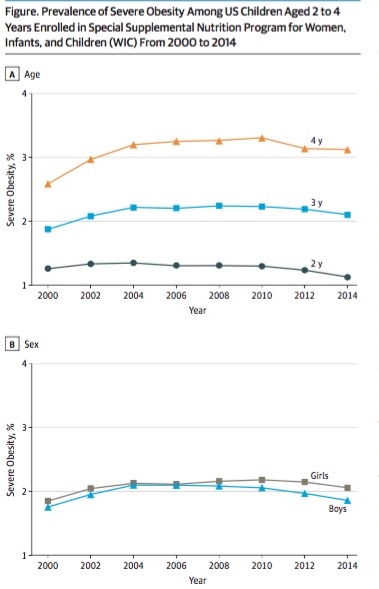Back in 2012, we noted the good news that the prevalence of obesity and severe obesity in children served by federal food assistance programs had diminished. The trend seems to be continuing according to more recent research. Between 2000 and 2014, the prevalence of severe obesity in children aged 2 to 4 years who were enrolled in the WIC (1) nutrition supplementation program, declined slightly, but significantly.
 Dr. Liping Pan from the CDC and colleagues analyzed data from 2-year cycles from young children enrolled in WIC programs in the 50 states and the District of Columbia. In total, data from over 22 million children were used, and the annual samples ranged from 2.3 to 3.3 million enrollees. In each iteration of the survey, the children were weighed and measured, and their Body Mass Indices (BMI) were calculated. Severe obesity was defined as a BMI greater than 120 percent of the 95th percentile of the sex-specific BMI for age.
Dr. Liping Pan from the CDC and colleagues analyzed data from 2-year cycles from young children enrolled in WIC programs in the 50 states and the District of Columbia. In total, data from over 22 million children were used, and the annual samples ranged from 2.3 to 3.3 million enrollees. In each iteration of the survey, the children were weighed and measured, and their Body Mass Indices (BMI) were calculated. Severe obesity was defined as a BMI greater than 120 percent of the 95th percentile of the sex-specific BMI for age.
As shown in the first figure at right (A), the prevalence of severe obesity increased with age. It increased for 3 and 4 year olds between 2004 and 2010, but then decreased significantly for all ages by 2014. The second figure (B) depicts severe obesity prevalence by gender, and girls typically showed a greater prevalence than boys since 2008; both sexes demonstrated a significantly decreased prevalence between 2010 and 2014.
The authors of the study noted that the reasons for the decline weren't clear, although they pointed out that the WIC food packages had been revised in 2009 to more closely align with Federal guidelines for healthy diets, promoting more fruits, vegetables and whole wheat purchases. Since it's well-known that obesity is linked to a myriad of negative health consequences, and the longer obesity has been in place the more likely such results will occur, these data provide some hope that we may be able to stem the obesity epidemic.
1. The Women, Infants, and Children Special Supplemental Nutrition Program (WIC): "provides Federal grants to States for supplemental foods, health care referrals, and nutrition education for low-income pregnant, breastfeeding, and non-breastfeeding postpartum women, and to infants and children up to age five who are found to be at nutritional risk."




